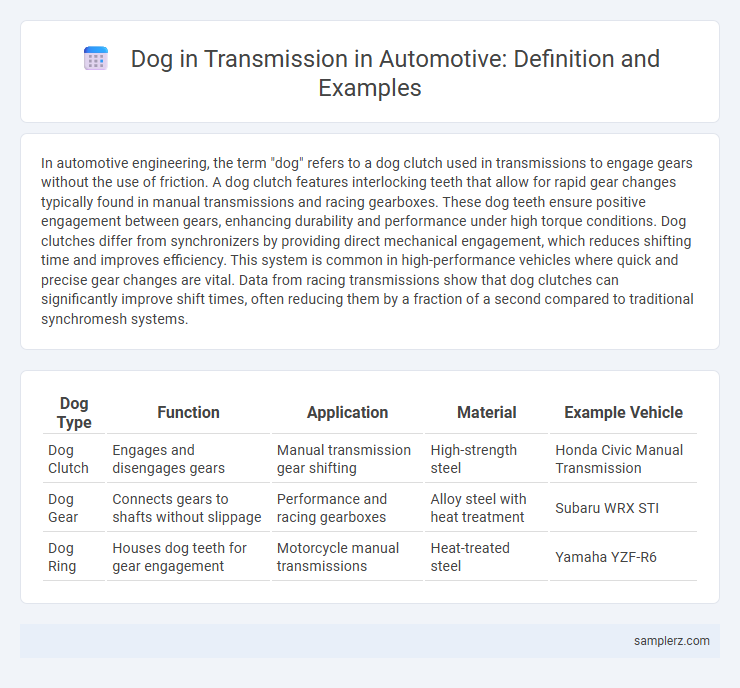In automotive engineering, the term "dog" refers to a dog clutch used in transmissions to engage gears without the use of friction. A dog clutch features interlocking teeth that allow for rapid gear changes typically found in manual transmissions and racing gearboxes. These dog teeth ensure positive engagement between gears, enhancing durability and performance under high torque conditions. Dog clutches differ from synchronizers by providing direct mechanical engagement, which reduces shifting time and improves efficiency. This system is common in high-performance vehicles where quick and precise gear changes are vital. Data from racing transmissions show that dog clutches can significantly improve shift times, often reducing them by a fraction of a second compared to traditional synchromesh systems.
Table of Comparison
| Dog Type | Function | Application | Material | Example Vehicle |
|---|---|---|---|---|
| Dog Clutch | Engages and disengages gears | Manual transmission gear shifting | High-strength steel | Honda Civic Manual Transmission |
| Dog Gear | Connects gears to shafts without slippage | Performance and racing gearboxes | Alloy steel with heat treatment | Subaru WRX STI |
| Dog Ring | Houses dog teeth for gear engagement | Motorcycle manual transmissions | Heat-treated steel | Yamaha YZF-R6 |
Understanding "Dog" in Automotive Transmissions
A dog in automotive transmissions refers to a dog clutch, a mechanical device that engages gears by interlocking teeth rather than using friction. This design enables rapid, positive gear shifts essential for performance vehicles and racing applications. Understanding the dog clutch's role improves insights into transmission efficiency and durability under high-stress conditions.
The Role of Dog Gears in Manual Transmissions
Dog gears in manual transmissions play a critical role in enabling quick and positive gear engagement without the need for synchromesh. These gears feature robust teeth that interlock directly with corresponding grooves on the gear hub, allowing torque transfer and precise control during gear shifts. Designed to handle high torque loads, dog gears are essential in performance and racing vehicles where rapid and reliable shifts are paramount.
How Dog Engagement Works in Performance Cars
Dog engagement in performance car transmissions involves interlocking teeth, or "dogs," on the gears and the dog rings, allowing rapid and precise gear shifts without using synchronizers. This mechanism enables faster power transfer and minimizes shift time by directly locking the desired gear to the shaft, crucial for racing and high-performance driving. The design reduces wear and provides robust engagement under high torque loads, enhancing reliability and driving dynamics in competitive automotive applications.
Key Differences: Synchromesh vs. Dog Transmission
Dog transmissions provide direct, positive engagement through precisely machined teeth, enabling rapid gear shifts with minimal power interruption, unlike synchromesh transmissions that use synchronizer rings to match gear speeds and facilitate smoother, quieter shifting. Synchromesh systems excel in everyday driving by reducing gear clash and enhancing drivability, whereas dog transmissions prioritize performance and durability in racing or high-stress automotive applications. The key difference lies in engagement method: dog transmissions use fixed teeth engagement for quick shifts, while synchromesh rely on friction to synchronize gears before engagement.
Advantages of Dog Gearboxes in Motorsports
Dog gearboxes in motorsports offer rapid gear shifts by enabling direct engagement without synchronizers, reducing shift times significantly. Their robust design enhances durability under high torque and aggressive driving conditions, ensuring reliable performance during races. This results in improved acceleration and control, giving drivers a competitive edge on the track.
Common Applications of Dog Transmission Systems
Dog transmission systems are commonly used in high-performance motorcycles and racing cars due to their rapid and precise gear engagement. These transmissions enable quicker shifts without interrupting power delivery, enhancing vehicle responsiveness and control. In off-road and heavy-duty vehicles, dog clutches provide durability and reliability under extreme torque conditions, making them ideal for demanding automotive applications.
Maintenance Tips for Dog-Engaged Transmissions
Regularly inspect dog teeth for wear or damage to prevent transmission slippage and ensure smooth gear engagement. Apply high-quality lubricant specifically designed for dog clutches to minimize friction and reduce heat buildup. Schedule routine cleaning to remove debris and contaminants that can impair the functionality of dog-engaged transmissions and extend their service life.
Signs of Wear in Dog Gear Mechanisms
Signs of wear in dog gear mechanisms often include difficulty engaging gears, unusual grinding noises, and increased play or slack in the transmission linkage. Visual inspection may reveal chipped, cracked, or rounded dog teeth on the gear components, which impair proper meshing and cause slippage. Timely identification of these wear indicators is crucial to prevent transmission failure and ensure smooth shifting performance.
Upgrading to a Dog Transmission: What to Consider
Upgrading to a dog transmission enhances shift speed and durability by eliminating synchromesh, making it ideal for racing and high-performance vehicles. Key considerations include compatibility with the existing drivetrain, the skill level required for smooth engagement, and potential noise increase during operation. Proper installation and maintenance ensure optimal performance and longevity of the dog engagement system in transmissions.
Future Trends in Dog Transmission Technology
Future trends in dog transmission technology emphasize enhanced durability and faster gear engagement through advanced materials like carbon composites and surface treatments that reduce wear. Integration with electronic control units (ECUs) enables precise synchronization for smoother shifting and improved fuel efficiency. Research also focuses on adaptive dog clutches that adjust engagement torque dynamically to optimize performance in autonomous and electric vehicles.

example of dog in transmission Infographic
 samplerz.com
samplerz.com